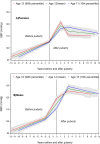Puberty Timing and Sex-Specific Trajectories of Systolic Blood Pressure: a Prospective Cohort Study
- PMID: 35587023
- PMCID: PMC9278704
- DOI: 10.1161/HYPERTENSIONAHA.121.18531
Puberty Timing and Sex-Specific Trajectories of Systolic Blood Pressure: a Prospective Cohort Study
Abstract
Background: Sex differences in systolic blood pressure (SBP) emerge during adolescence but the role of puberty is not well understood. We examined sex-specific changes in SBP preceding and following puberty and examined the impact of puberty timing on SBP trajectories in females and males.
Methods: Trajectories of SBP before and after puberty and by timing of puberty in females and males in a contemporary birth cohort study were analyzed. Repeated measures of height from age 5 to 20 years were used to identify puberty timing (age at peak height velocity). SBP was measured on ten occasions from 3 to 24 years (N participants, 4062; repeated SBP measures, 29 172). Analyses were performed using linear spline multilevel models based on time before and after puberty and were adjusted for parental factors and early childhood factors.
Results: Mean age at peak height velocity was 11.7 years (SD, 0.8) for females and 13.6 years (SD, 0.9) for males. Males had faster rates of increase in SBP before puberty leading to 10.19 mm Hg (95% CI, 6.80-13.57) higher mean SBP at puberty which remained similar at 24 years (mean difference, 11.43 mm Hg [95% CI, 7.22-15.63]). Puberty timing was associated with small transient differences in SBP trajectories postpuberty in both sexes and small differences at 24 years in females only.
Conclusions: A large proportion of the higher SBP observed in males compared with females in early adulthood is accrued before puberty. Interventions targeting puberty timing are unlikely to influence SBP in early adulthood.
Keywords: blood pressure; cardiovascular diseases; puberty; risk factor.
Figures


References
-
- Rapsomaniki E, Timmis A, George J, Pujades-Rodriguez M, Shah AD, Denaxas S, White IR, Caulfield MJ, Deanfield JE, Smeeth L, et al. . Blood pressure and incidence of twelve cardiovascular diseases: lifetime risks, healthy life-years lost, and age-specific associations in 1·25 million people. Lancet. 2014;383:1899–1911. doi: 10.1016/S0140-6736(14)60685-1 - PMC - PubMed
-
- Lewington S, Clarke R, Qizilbash N, Peto R, Collins R; Prospective studies collaboration. Age-specific relevance of blood pressure to cause-specific mortality is best assessed by collaborative meta-analysis of individual participant data from the separate prospective studies. Lancet. 2002;360:1903–1913. doi: 10.1016/s0140-6736(02)11911-8 - PubMed
Publication types
MeSH terms
Grants and funding
LinkOut - more resources
Full Text Sources
Medical

